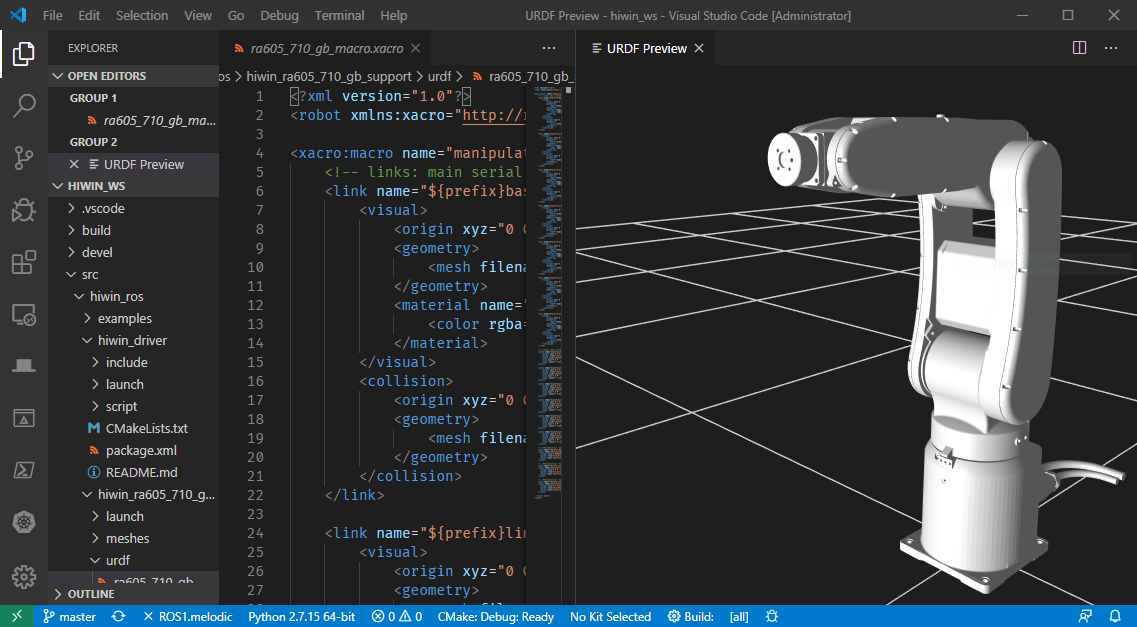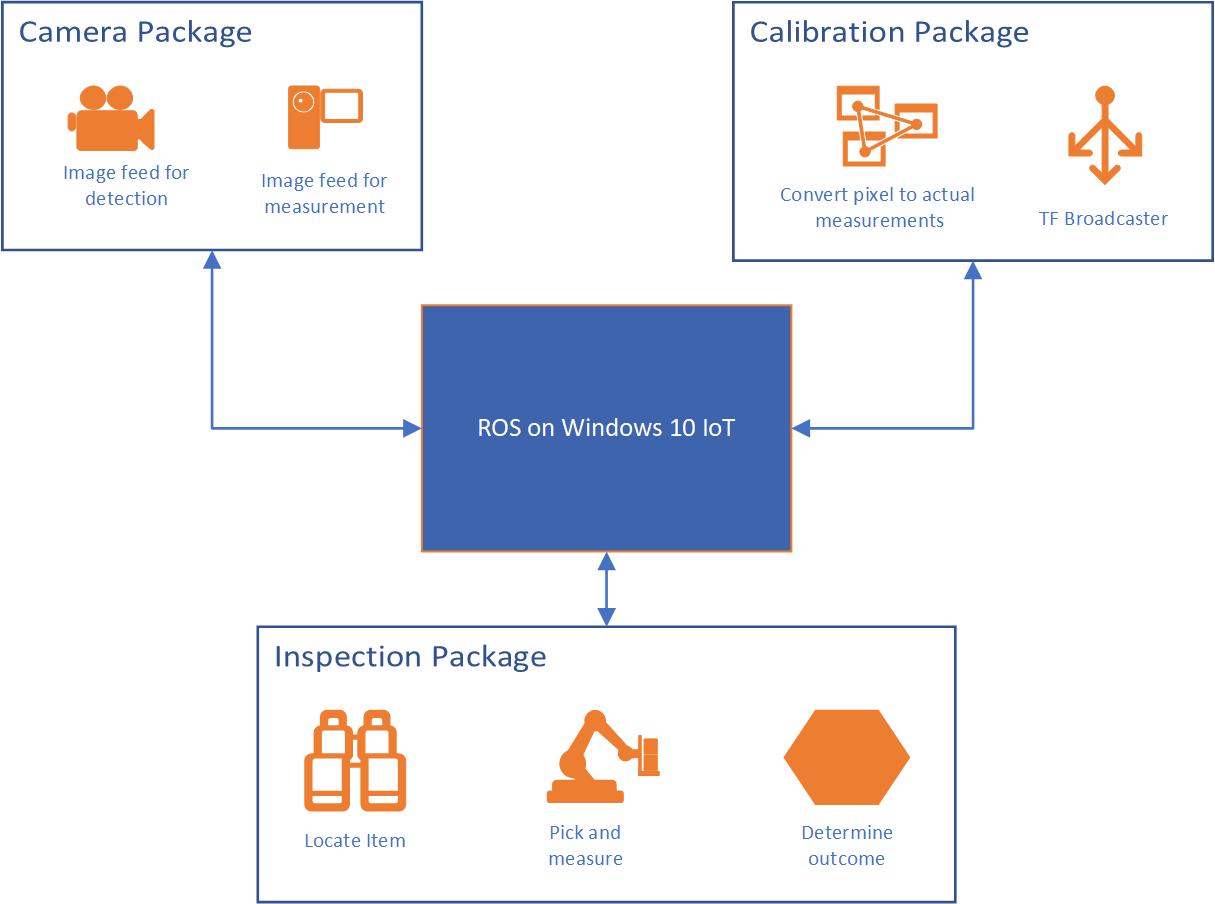HIWIN robots use ROS on Windows
HIWIN, a Taiwan-based enterprise is a global manufacturer of Linear Motion Control products such as Linear Guideways, Linear Motors, Single Axis robots, Ball screws etc. Riding the wave of Industry 4.0, Hiwin is focused on intelligent automation for the manufacturing space with a compelling fleet of flexible and highly-precise robots for jobs such as pick and place, welding, stacking and complex machining.
Microsoft Windows has been a trusted platform for robots and industrial systems for decades. We are working towards bringing the intelligent edge computing to robots using Windows. To that end, in May, 2019, Microsoft working in collaboration with Open Robotics announced the general availability of the Robot Operating System ROS™ 1 on Windows 10 IoT Enterprise. Microsoft is also an active member of the ROS-2 Technical Steering Committee and ROS Industrial Consortium. Microsoft also released the Visual Studio Code extension for ROS which includes the Unified Robotic Description Format (URDF) preview and debugging capabilities.
HIWIN Robot URDF Preview

When HIWIN was exploring ways in which they can meet their customer’s evolving needs, they chose to use ROS on Windows. The ROS framework made it easy for them to develop and maintain their code. Using ROS on industrial robots enabled them to easily add cognitive capabilities to the robot. Bobby Liao, the Plant General Manager at HIWIN says “ROS on Windows, integrated with Azure services, allowed us to develop smart solutions for our customers’ needs, giving us the possibility to use our robots for innovative applications, using speech recognition, language understanding and speech-to-text capabilities. We are also looking forward to further develop using ROS2, which promises to address some of the weak points in ROS1”
HIWIN used the Visual Studio Code extension for ROS which made it very easy to develop new robotic models using the Unified Robot Description Format(URDF) preview feature. This helped create the simulated robots and iterate quickly with their customers. “Visual Studio Code allowed us to develop ROS support packages for our Robots and Grippers in a fraction of the time otherwise needed. Using the URDF preview, we were able to simulate the robotic arms on-the-fly, which was extremely convenient for development.” says Giovanni Ventilii, a research developer and engineer at HIWIN.
The advantages of using ROS on Windows meant that they could also use their existing DLLs in their code, making it easy to continue developing their robotic controller on the Windows platform. HIWIN built the following ROS nodes using Azure Cognitive Services and deployed them as containers on the edge. A combination of these nodes enabled them to transform processes on the manufacturing floor, optimizing tasks such as pick and place, anomaly detection of manufactured parts and using voice activated robotic arms to perform high precision jobs.
Here are some of the ROS nodes that HIWIN created:
- Speech to Text and Text to speech nodes that enabled users to provide voice commands to the robot using Azure Speech services. The robot processes the command, performs the required task and responds back to the user using the text-to-speech node.
- Language Understanding Node converted conversational data into a task plan for the robot to execute on
- Vision node that processes images from a industrial camera sensors, produces measurements of parts using images and classifies images
- IoT Central node that connects to Azure IoT Central enabling the management of robots across multiple customer sites.
Below is a couple of architectures where these components work together to achieve a goal.
HIWIN Robot with Speech Cognitive Capabilities

HIWIN Robot with Vision Cognitive Capabilities

Why HIWIN chose Windows 10 IoT
Using Windows 10 IoT as the OS meant having a fast, secure and smart platform to build their solution on.
- Windows 10 IoT provided them with the same familiar frameworks and development environments that were easy and comfortable to use with the in-house development teams. Standards based connectivity meant that it was easier to get devices and components to communicate with each other.
- With multi-layer security advances, Windows 10 IoT provides HIWIN with an un-paralleled security advantage. A long term servicing channel for 10 years and a corporate-wide team of security experts who are focused on making Windows 10 safe ensures that HIWIN’s robotic solutions are secure and protected.
- Using Windows 10 IoT is a smart choice as Windows 10 IoT is optimized to work with Azure services enabling HIWIN to quickly, build, deploy and scale their robotic solutions. With real-time insights and analytic capabilities, the Windows platform allows developers to do more at the edge using the cognitive and machine learning services of Azure. “The integration with Azure cloud services is what we think makes Windows suitable for intelligent industrial robotics application which more than often require cloud and edge computing power” says Bobby Liao at HIWIN.
During the 2019 Taiwan Automation Intelligence and Robot Show (TAIROS), HIWIN showcased their robots running ROS on Windows.
To learn more about ROS on Windows visit https://aka.ms/ros. Do try it out and reach out to us on our GitHub repo with your questions and feedback. More on HIWIN’s ROS implementation here https://github.com/HIWINCorporation/hiwin_ros
DISCLAIMER: This document is for informational purposes only. MICROSOFT MAKES NO WARRANTIES, EXPRESS OR IMPLIED, IN THIS SUMMARY.
-
ROS is a trademark of Open Robotics ↩